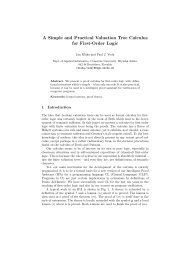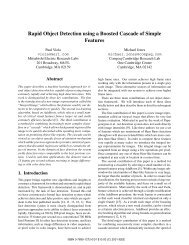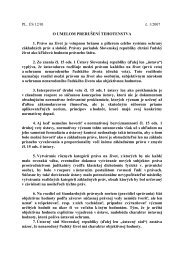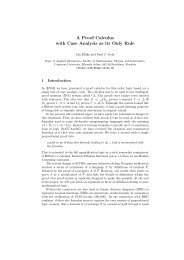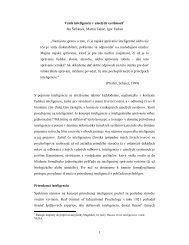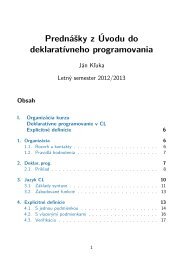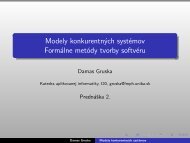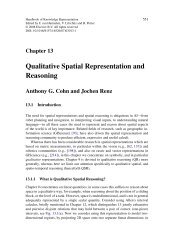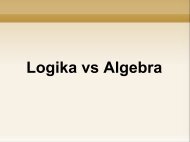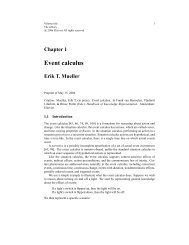Web Ontology Language: OWL - Vrije Universiteit Amsterdam
Web Ontology Language: OWL - Vrije Universiteit Amsterdam
Web Ontology Language: OWL - Vrije Universiteit Amsterdam
Create successful ePaper yourself
Turn your PDF publications into a flip-book with our unique Google optimized e-Paper software.
<strong>Web</strong> <strong>Ontology</strong> <strong>Language</strong>: <strong>OWL</strong>Grigoris Antoniou 1 and Frank van Harmelen 21 Department of Computer Science, University of Crete, ga@csd.uoc.gr2 Department of AI, <strong>Vrije</strong> <strong>Universiteit</strong> <strong>Amsterdam</strong>,Frank.van.Harmelen@cs.vu.nl1 Motivation and OverviewThe expressivity of RDF and RDF Schema that was described in [12] is deliberatelyvery limited: RDF is (roughly) limited to binary ground predicates,and RDF Schema is (again roughly) limited to a subclass hierarchy and aproperty hierarchy, with domain and range definitions of these properties.However, the <strong>Web</strong> <strong>Ontology</strong> Working Group of W3C 3 identified a numberof characteristic use-cases for Ontologies on the <strong>Web</strong> which would requiremuch more expressiveness than RDF and RDF Schema.A number of research groups in both America and Europe had alreadyidentified the need for a more powerful ontology modelling language. Thislead to a joint initiative to define a richer language, called DAML+OIL 4 (thename is the join of the names of the American proposal DAML-ONT 5 , andthe European language OIL 6 ).DAML+OIL in turn was taken as the starting point for the W3C <strong>Web</strong><strong>Ontology</strong> Working Group in defining <strong>OWL</strong>, the language that is aimed tobe the standardised and broadly accepted ontology language of the Semantic<strong>Web</strong>.In this chapter, we first describe the motivation for <strong>OWL</strong> in terms of itsrequirements, and the resulting non-trivial relation with RDF Schema. Wethen describe the various language elements of <strong>OWL</strong> in some detail.Requirements for ontology languages<strong>Ontology</strong> languages allow users to write explicit, formal conceptualizations ofdomains models. The main requirements are:3 http://www.w3.org/2001/sw/<strong>Web</strong>Ont/4 http://www.daml.org/2001/03/daml+oil-index.html5 http://www.daml.org/2000/10/daml-ont.html6 http://www.ontoknowledge.org/oil/
2 Grigoris Antoniou and Frank van Harmelen1. a well-defined syntax2. a well-defined semantics3. efficient reasoning support4. sufficient expressive power5. convenience of expression.The importance of a well-defined syntax is clear, and known from the area ofprogramming languages; it is a necessary condition for machine-processing ofinformation. All the languages we have presented so far have a well-definedsyntax. DAML+OIL and <strong>OWL</strong> build upon RDF and RDFS and have thesame kind of syntax.Of course it is questionable whether the XML-based RDF syntax is veryuser-friendly, there are alternatives better suitable for humans (for example,see the OIL syntax). However this drawback is not very significant, becauseultimately users will be developing their ontologies using authoring tools, ormore generally ontology development tools, instead of writing them directly inDAML+OIL or <strong>OWL</strong>.Formal semantics describes precisely the meaning of knowledge. “Precisely”here means that the semantics does not refer to subjective intuitions,nor is it open to different interpretations by different persons (or machines).The importance of formal semantics is well-established in the domain of mathematicallogic, among others.One use of formal semantics is to allow humans to reason about the knowledge.For ontological knowledge we may reason about:• Class membership: If x is an instance of a class C, and C is a subclass ofD, then we can infer that x is an instance of D.• Equivalence of classes: If class A is equivalent to class B, and class Bequivalent to class C, then A is equivalent to C, too.• Consistency: Suppose we have declared x to be an instance of the class A.Further suppose that- A is a subclass of B ∩ C- A is a subclass of D- B and D are disjointThen we have an inconsistency because A should be empty, but has theinstance x. This is an indication of an error in the ontology.• Classification: If we have declared that certain property-value pairs aresufficient condition for membership of a class A, then if an individual xsatisfies such conditions, we can conclude that x must be an instance ofA.Semantics is a prerequisite for reasoning support: Derivations such as the abovecan be made mechanically, instead of being made by hand. Reasoning supportis important because it allows one to• check the consistency of the ontology and the knowledge;
• check for unintended relationships between classes.• automatically classify instances in classes<strong>Web</strong> <strong>Ontology</strong> <strong>Language</strong>: <strong>OWL</strong> 3Automated reasoning support allows one to check many more cases than whatcan be done manually. Checks like the above are valuable for• designing large ontologies, where multiple authors are involved;• integrating and sharing ontologies from various sources.Formal semantics and reasoning support is usually provided by mapping anontology language to a known logical formalism, and by using automatedreasoners that already exist for those formalisms. We will see that <strong>OWL</strong> is(partially) mapped on a description logic, and makes use of existing reasonerssuch as FaCT and RACER.Description logics are a subset of predicate logic for which efficient reasoningsupport is possible. See [13] for more detail.Limitations of the expressive power of RDF SchemaRDF and RDFS allow the representation of some ontological knowledge. Themain modelling primitives of RDF/RDFS concern the organization of vocabulariesin typed hierarchies: subclass and subproperty relationships, domainand range restrictions, and instances of classes. However a number of otherfeatures are missing. Here we list a few:• Local scope of properties: rdfs:range defines the range of a property,say eats, for all classes. Thus in RDF Schema we cannot declare rangerestrictions that apply to some classes only. For example, we cannot saythat cows eat only plants, while other animals may eat meat, too.• Disjointness of classes: Sometimes we wish to say that classes are disjoint.For example, male and female are disjoint. But in RDF Schema we canonly state subclass relationships, e.g. female is a subclass of person.• Boolean combinations of classes: Sometimes we wish to build new classesby combining other classes using union, intersection and complement. Forexample, we may wish to define the class person to be the disjoint union ofthe classes male and female. RDF Schema does not allow such definitions.• Cardinality restrictions: Sometimes we wish to place restrictions on howmany distinct values a property may or must take. For example, we wouldlike to say that a person has exactly two parents, and that a course istaught by at least one lecturer. Again such restrictions are impossible toexpress in RDF Schema.• Special characteristics of properties: Sometimes it is useful to say that aproperty is transitive (like “greater than”), unique (like “is mother of”),or the inverse of another property (like “eats” and “is eaten by”).
4 Grigoris Antoniou and Frank van HarmelenSo we need an ontology language that is richer than RDF Schema, a languagethat offers these features and more. In designing such a language one shouldbe aware of the tradeoff between expressive power and efficient reasoning support.Generally speaking, the richer the language is, the more inefficient thereasoning support becomes, often crossing the border of non-computability.Thus we need a compromise, a language that can be supported by reasonablyefficient reasoners, while being sufficiently expressive to express large classesof ontologies and knowledge.Compatibility of <strong>OWL</strong> with RDF/RDFSIdeally, <strong>OWL</strong> would be an extension of RDF Schema, in the sense that<strong>OWL</strong> would use the RDF meaning of classes and properties ( rdfs:Class,rdfs:subClassOf, etc), and would add language primitives to support thericher expressiveness identified above.Unfortunately, the desire to simply extend RDF Schema clashes withthe trade-off between expressive power and efficient reasoning mentioned before.RDF Schema has some very powerful modelling primitives, such as therdfs:Class (the class of all classes) and rdf:Property (the class of all properties).These primitives are very expressive, and will lead to uncontrollablecomputational properties if the logic is extended with the expressive primitivesidentified above.Three species of <strong>OWL</strong>All this as lead to a set of requirements that may seem incompatible: efficientreasoning support and convenience of expression for a language as powerfulas a combination of RDF Schema with a full logic.Indeed, these requirements have prompted W3C’s <strong>Web</strong> <strong>Ontology</strong> WorkingGroup to define <strong>OWL</strong> as three different sublanguages, each of which is gearedtowards fulfilling different aspects of these incompatible full set of requirements:• <strong>OWL</strong> Full: The entire language is called <strong>OWL</strong> Full, and uses all the <strong>OWL</strong>languages primitives (which we will discuss later in this chapter). It alsoallows to combine these primitives in arbitrary ways with RDF and RDFSchema. This includes the possibility (also present in RDF) to change themeaning of the pre-defined (RDF or <strong>OWL</strong>) primitives, by applying thelanguage primitives to each other. For example, in <strong>OWL</strong> Full we could imposea cardinality constraint on the class of all classes, essentially limitingthe number of classes that can be described in any ontology.The advantage of <strong>OWL</strong> Full is that it is fully upward compatible withRDF, both syntactically and semantically: any legal RDF document is alsoa legal <strong>OWL</strong> Full document, and any valid RDF/RDF Schema conclusionis also a valid <strong>OWL</strong> Full conclusion.
<strong>Web</strong> <strong>Ontology</strong> <strong>Language</strong>: <strong>OWL</strong> 5The disadvantage of <strong>OWL</strong> Full is the language has become so powerfulas to be undecidable, dashing any hope of complete (let alone efficient)reasoning support.• <strong>OWL</strong> DL: In order to regain computational efficiency, <strong>OWL</strong> DL (shortfor: Description Logic) is a sublanguage of <strong>OWL</strong> Full which restricts theway in which the constructors from <strong>OWL</strong> and RDF can be used. We willgive details later, but roughly this amounts to disallowing application of<strong>OWL</strong>’s constructor’s to each other, and thus ensuring that the languagecorresponds to a well studied description logic.The advantage of this is that it permits efficient reasoning support.The disadvantage is that we loose full compatibility with RDF: an RDFdocument will in general have to be extended in some ways and restrictedin others before it is a legal <strong>OWL</strong> DL document. Conversely, every legal<strong>OWL</strong> DL document is still a legal RDF document.• <strong>OWL</strong> Lite: An ever further restriction limits <strong>OWL</strong> DL to a subset ofthe language constructors. For example, <strong>OWL</strong> Lite excludes enumeratedclasses, disjointness statements and arbitrary cardinality (among others).The advantage of this is a language that is both easier to grasp (for users)and easier to implement (for tool builders).The disadvantage is of course a restricted expressivity.<strong>Ontology</strong> developers adopting <strong>OWL</strong> should consider which sublanguagebest suits their needs. The choice between <strong>OWL</strong> Lite and <strong>OWL</strong> DL depends onthe extent to which users require the more-expressive constructs provided by<strong>OWL</strong> DL and <strong>OWL</strong> Full. The choice between <strong>OWL</strong> DL and <strong>OWL</strong> Full mainlydepends on the extent to which users require the meta-modeling facilitiesof RDF Schema (e.g. defining classes of classes, or attaching properties toclasses). When using <strong>OWL</strong> Full as compared to <strong>OWL</strong> DL, reasoning support isless predictable since complete <strong>OWL</strong> Full implementations will be impossible.There are strict notions of upward compatibility between these three sublanguages:• Every legal <strong>OWL</strong> Lite ontology is a legal <strong>OWL</strong> DL ontology.• Every legal <strong>OWL</strong> DL ontology is a legal <strong>OWL</strong> Full ontology.• Every valid <strong>OWL</strong> Lite conclusion is a valid <strong>OWL</strong> DL conclusion.• Every valid <strong>OWL</strong> DL conclusion is a valid <strong>OWL</strong> Full conclusion.<strong>OWL</strong> still uses RDF and RDF Schema to a large extent:• all varieties of <strong>OWL</strong> use RDF for their syntax• instances are declared as in RDF, using RDF descriptions and typing information• <strong>OWL</strong> constructors like owl:Class, owl:DatatypeProperty andowl:ObjectProperty are all specialisations of their RDF counterparts.Figure 1 shows the subclass relationships between some modelling primitivesof <strong>OWL</strong> and RDF/RDFS.
6 Grigoris Antoniou and Frank van Harmelenrdfs:Resourcerdfs:Classrdf:Propertyowl:Classowl:ObjectPropertyowl:DatatypePropertyFig. 1. Subclass relationships between <strong>OWL</strong> and RDF/RDFSThe original hope in the design of <strong>OWL</strong> was that there would be a downwardcompatibility with corresponding re-use of software across the variouslayers. However, the advantage of full downward compatibility for <strong>OWL</strong> (thatany <strong>OWL</strong> aware processor will also provide correct interpretations of any RDFSchema document) is only achieved for <strong>OWL</strong> Full, at the cost of computationalintractability.Chapter overviewSection 2 presents <strong>OWL</strong> in some detail. Because <strong>OWL</strong> is such a new language,only very limited examples of its use have been published. Section 3 thereforeillustrates the language by giving a few examples.2 The <strong>OWL</strong> <strong>Language</strong>Syntax<strong>OWL</strong> builds on RDF and RDF Schema, and uses RDF’s XML syntax. Sincethis is the primary syntax for <strong>OWL</strong>, we will use it here, but it will soon becomeclear that RDF/XML does not provide a very readable syntax. Because of this,other syntactic forms for <strong>OWL</strong> have also been defined:• an XML-based syntax which does not follow the RDF conventions. Thismakes this syntax already significantly easier to read by humans.• an abstract syntax which is used in the language specification document.This syntax is much more compact and readable then either the XMLsyntax or the RDF/XML syntax• a graphical syntax based on the conventions of the UML language (UniversalModelling <strong>Language</strong>). Since UML is widely used, this will be aneasy way for people to get familiar with <strong>OWL</strong>.
<strong>Web</strong> <strong>Ontology</strong> <strong>Language</strong>: <strong>OWL</strong> 7Header<strong>OWL</strong> documents are usually called <strong>OWL</strong> ontologies, and are RDF documents.So the root element of a <strong>OWL</strong> ontology is an rdf:RDF element which alsospecifies a number of namespaces. For example:An <strong>OWL</strong> ontology may start with a collection of assertions for housekeepingpurposes. These assertions are grouped under an owl:<strong>Ontology</strong> elementwhich contains comments, version control and inclusion of other ontologies.For example:An example <strong>OWL</strong> ontologyUniversity <strong>Ontology</strong>The only of these assertions which has any consequences for the logicalmeaning of the ontology is owl:imports: this lists other ontologies whosecontent is assumed to be part of the current document. ontology. Notice thatwhile namespaces are used for disambiguation purposes, imported ontologiesprovide definitions that can be used. Usually there will be an import elementfor each used namespace, but it is possible to import additional ontologies,for example ontologies that provide definitions without introducing any newnames.Also note that owl:imports is a transitive property: if ontology A importsontology B, and ontology B imports ontology C, then ontology A also importsontology C.Class elementsClasses are defined using a owl:Class element 7 . For example, we can definea class associateProfessor as follows:7 owl:Class is a subclass of rdfs:Class.
8 Grigoris Antoniou and Frank van HarmelenWe can also say that this class is disjoint from the professor andassistantProfessor classes using owl:disjointWith elements. These elementscan be included in the definition above, or can be added by referringto the id using rdf:about. This mechanism is inherited from RDF.Equivalence of classes can be defined using a owl:equivalentClass element:Finally, there are two predefined classes, owl:Thing and owl:Nothing. Theformer is the most general class which contains everything (everything isa thing), the latter is the empty class. Thus every class is a subclass ofowl:Thing and a superclass of owl:Nothing.Property elementsIn <strong>OWL</strong> there are two kinds of properties:• Object properties which relate objects to other objects.Examples are isTaughtBy, supervises etc.• Datatype properties which relate objects to datatype values.Examples are phone, title, age etc. <strong>OWL</strong> does not have any predefineddata types, nor does it provide special definition facilities. Instead it allowsone to use XML Schema data types, thus making use of the layeredarchitecture the Semantic <strong>Web</strong>Here is an example of a datatype property.User-defined data types will usually be collected in an XML schema, and thenused in an <strong>OWL</strong> ontology.Here is an example of an object property:
<strong>Web</strong> <strong>Ontology</strong> <strong>Language</strong>: <strong>OWL</strong> 9More than one domain and range may be declared. In this case the intersectionof the domains, respectively ranges, is taken.<strong>OWL</strong> allows us to relate “inverse properties”. A typical example isisTaughtBy and teaches.Actually domain and range can be inherited from the inverse property (interchangedomain with range).Equivalence of properties can be defined using a owl:equivalentPropertyelement.Property restrictionsWith rdfs:subClassOf we can specify a class C to be subclass of anotherclass C ′ ; then every instance of C is also an instance of C ′ .Now suppose we wish to declare, instead, that the class C satisfies certainconditions, that is, all instances of C satisfy the conditions. Obviously it isequivalent to saying that C is subclass of a class C ′ , where C ′ collects allobjects that satisfy the conditions. That is exactly how it is done in <strong>OWL</strong>,as we will show. Note that, in general, C ′ can remain anonymous, as we willexplain below.The following element requires first year courses to be taught by professorsonly (according to a questionable view, older and more senior academics arebetter at teaching).owl:allValuesFrom is used to specify the class of possible values the propertyspecified by owl:onProperty can take (in other words: all values of the propertymust come from this class). In our example, only professors are allowedas values of the property isTaughtBy.We can declare that mathematics courses are taught by David Billingtonas follows:
10 Grigoris Antoniou and Frank van Harmelenowl:hasValue states a specific value that the property, specified byowl:onProperty must have.And we can declare that all academic staff members must teach at leastone undergraduate course as follows:Let us compare owl:allValuesFrom and owl:someValuesFrom. The exampleusing the former requires every person who teaches an instance of theclass, a first year subject, to be a professor. In terms of logic we have a universalquantification.The example using the latter requires that there exists an undergraduatecourse that is taught by an instance of the class, an academic staff member.It is still possible that the same academic teaches postgraduate courses, inaddition. In terms of logic we have an existential quantification.In general, a owl:Restriction element contains a owl:onProperty element,and one or more restriction declarations. One type of restriction declarationsare those that define restrictions on the kinds of values the propertycan take:owl:allValuesFrom, owl:hasValue and owl:someValuesFrom. Another typeare cardinality restrictions. For example, we can require every course to betaught by at least someone.1
<strong>Web</strong> <strong>Ontology</strong> <strong>Language</strong>: <strong>OWL</strong> 11Notice that we had to specify that the literal “1” is to be interpretedas a nonNegativeInteger (instead of, say, a string), and that we used thexsd namespace declaration made in the header element to refer to the XMLSchema document.Or we might specify that, for practical reasons, a department must haveat least ten and at most thirty members.1030It is possible to specify a precise number. For example, a PhD studentmust have exactly two supervisors. This can be achieved by using the samenumber inowl:minCardinality and owl:maxCardinality. For convenience, <strong>OWL</strong> offersalso owl:cardinality.We conclude by noting that owl:Restriction defines an anonymous classwhich has no id, is not defined by owl:Class and has only a local scope: itcan only be used in the one place where the restriction appears. When we talkabout classes please bare in mind the twofold meaning: classes that are definedby owl:Class with an id, and local anonymous classes as collections of objectsthat satisfy certain restriction conditions, or as combinations of other classes,as we will see shortly. The latter are sometimes called class expressions.Special propertiesSome properties of property elements can be defined directly:• owl:TransitiveProperty defines a transitive property, such as “has bettergrade than”, “is taller than”, “is ancestor of” etc.• owl:SymmetricProperty defines a symmetric property, such as “has samegrade as”, “is sibling of”, etc.• owl:FunctionalProperty defines a property that has at most one uniquevalue for each object, such as “age”, “height”, “directSupervisor” etc.• owl:InverseFunctionalProperty defines a property for which two differentobjects cannot have the same value, for example the property “is-TheSocialSecurityNumberfor” (a social security number is assigned to oneperson only).
12 Grigoris Antoniou and Frank van HarmelenAn example of the syntactic form of the above is:Boolean combinationsIt is possible to talk about Boolean combinations (union, intersection, complement)of classes (be it defined by owl:Class or by class expressions). Forexample, we can say that courses and staff members are disjoint as follows:This says that every course is an instance of the complement of staff members,that is, no course is a staff member. Note that this statement could also havebeen expressed using owl:disjointWith.The union of classes is built using owl:unionOf.The rdf:parseType attribute is a shorthand for an explicit syntax forbuilding list with and tags. Such lists are requiredbecause the built-in containers of RDF have a serious limitation: there is noway to close them, i.e., to say “these are all the members of the container”.This is because, while one graph may describe some of the members, there isno way to exclude the possibility that there is another graph somewhere thatdescribes additional members. The list syntax provides exactly this facility,but is very verbose, which motivates the rdf:parseType shorthand notation.Note that this does not say that the new class is a subclass of the union,but rather that the new class is equal to the union. In other words, we havestated an equivalence of classes. Also, we did not specify that the two classesmust be disjoint: it is possible that a staff member is also a student.Intersection is stated with owl:intersectionOf.
<strong>Web</strong> <strong>Ontology</strong> <strong>Language</strong>: <strong>OWL</strong> 13Note that we have built the intersection of two classes, one of which was definedanonymously: the class of all objects belonging to the CS department.This class is intersected with faculty to give us the faculty in the CS department.Further we note that Boolean combinations can be nested arbitrarily. Thefollowing example defines administrative staff to be those staff members thatare neither faculty nor technical support staff.EnumerationsAn enumeration is a owl:oneOf element, and is used to define a class by listingall its elements.InstancesInstances of classes are declared as in RDF. For example:
14 Grigoris Antoniou and Frank van Harmelenor equivalently:We can also provide further details, such as:39Unlike typical database systems, <strong>OWL</strong> does not adopt the unique namesassumption, thus: just because two instances have a different name (or: ID),that does not imply that they are indeed different individuals. For example,if we state that each course is taught by at most one one staff member:and we subsequently state that a given course is taught by two staff members:this does not cause an <strong>OWL</strong> reasoner to flag an error. After all, the systemcould validly infer that the resources "949318" and "949352" are apparentlyequal. To ensure that different individuals are indeed recognised as such, wemust explicitly assert their inequality:Because such inequality statements occur frequently, and the requirednumber of such statements would explode if we wanted to state the inequalityof a large number of individuals, <strong>OWL</strong> provides a shorthand notation to assertthe pairwise inequality of all individuals in a given list:
<strong>Web</strong> <strong>Ontology</strong> <strong>Language</strong>: <strong>OWL</strong> 15Note that owl:distinctMembers can only be used in combination withowl:AllDifferent.DatatypesAlthough XML Schema provides a mechanism to construct user-defineddatatypes (e.g. the datatype of adultAge as all integers greater than 18, orthe datatype of all strings starting with a number), such derived datatypescannot be used in <strong>OWL</strong>. In fact, not even all of of the many the built-in XMLSchema datatypes can be used in <strong>OWL</strong>. The <strong>OWL</strong> reference document listsall the XML Schema datatypes that can be used, but these include the mostfrequently used types such as string, integer, boolean, time and date.Versioning informationWe have already seen the owl:priorVersion statement as part of the headerinformation to indicate earlier versions of the current ontology. This informationhas not formal model-theoretic semantics but can be exploited by humansreaders and programs alike for the purposes of ontology management.Besides owl:priorVersion, <strong>OWL</strong> has three more statements to indicate furtherinformal versioning information. None of these carry any formal meaning.• An owl:versionInfostatement generally contains a string giving informationabout the current version, for example RCS/CVS keywords.• An owl:backwardCompatibleWith statement contains a reference to anotherontology. This identifies the specified ontology as a prior version ofthe containing ontology, and further indicates that it is backward compatiblewith it. In particular, this indicates that all identifiers from theprevious version have the same intended interpretations in the new version.Thus, it is a hint to document authors that they can safely changetheir documents to commit to the new version (by simply updating namespacedeclarations and owl:imports statements to refer to the URL of thenew version).• An owl:incompatibleWith on the other hand indicates that the containingontology is a later version of the referenced ontology, but is not backwardcompatible with it. Essentially, this is for use by ontology authorswho want to be explicit that documents cannot upgrade to use the newversion without checking whether changes are required.Layering of <strong>OWL</strong>Now that we have discussed all the language constructors of <strong>OWL</strong>, we cancompletely specify which features of the language can be used in which sublanguage(<strong>OWL</strong> Full, DL and Lite):
16 Grigoris Antoniou and Frank van Harmelen<strong>OWL</strong> FullIn <strong>OWL</strong> Full, all the language constructors can be used in any combinationas long as the result is legal RDF.<strong>OWL</strong> DLIn order to exploit the formal underpinnings and computational tractabilityof Description Logics, the following constraints must be obeyed in an <strong>OWL</strong>DL ontology:• Vocabulary Partitioning: any resource is allowed to be only either a class,a datatype, a datatype properties, an object properties, an individuals, adata value or part of the built-in vocabulary, and not more than one ofthese. This means that, for example, a class cannot be at the same timean individual, or that a property cannot have values some values from adatatype and some values from a class (this would make it both a datatypeproperty and an object property).• Explicit typing: not only must all resources be partitioned (as prescribedin the previous constraint), but this partitioning must be stated explicitly.For example, if an ontology contains the following:this already entails that C2 is a class (by virtue of the range specificationof rdfs:subClassOf). Nevertheless, an <strong>OWL</strong> DL ontology must explicitlystate this information:• Property Separation: By virtue of the first constraint, the set of objectproperties and datatype properties are disjoint. This implies that inverseproperties, and functional, inverse functional and symmetric characteristicscan never be specified for datatype properties.• No transitive cardinality restrictions: no cardinality restrictions may beplaced on transitive properties (or their subproperties, which are of coursealso transitive, by implication).• Restricted anonymous classes: anonymous classes are only allowed in thedomain and range of owl:equivalentClass and owl:disjointWith, andin the range (not the domain) of rdfs:subClassOf.<strong>OWL</strong> LiteAn <strong>OWL</strong> ontology must be an <strong>OWL</strong> DL ontology, and must further satisfythe following constraints:• the constructors owl:oneOf, owl:disjointWith, owl:unionOf,owl:complementOf and owl:hasValue are not allowed
<strong>Web</strong> <strong>Ontology</strong> <strong>Language</strong>: <strong>OWL</strong> 17• cardinality statements (both minimal, maximal and exact cardinality) canonly be made on the values 0 or 1, and no longer on arbitrary non-negativeintegers.• owl:equivalentClass statements can no longer be made between anonymousclasses, but only between class identifiers.3 Examples3.1 An African Wildlife <strong>Ontology</strong>This example shows an ontology that describes part of the African wildlife.Figure 2 shows the basic classes and their subclass relationships.animalplantherbivorecarnivoretreegiraffelionFig. 2. Classes and subclasses of the African wildlife ontologyNote that the subclass information is only part of the information includedin the ontology. The entire graph is much bigger. Figure 3 shows the graphicalrepresentation of the statement that branches are parts of trees.onPropertyisPartOfbranchisSubclassOftoClasstreeFig. 3. Branches are parts of treesBelow we show the ontology, with comments written using rdfs:comment.
18 Grigoris Antoniou and Frank van HarmelenMy example version 1.2, 17 October 2002Animals form a classPlants form a class disjoint from animalsTrees are a type of plantsBranches are parts of trees Leaves are parts of branches
<strong>Web</strong> <strong>Ontology</strong> <strong>Language</strong>: <strong>OWL</strong> 19Herbivores are exactly those animals that eat only plants,or parts of plantsCarnivores are exactly those animalsthat eat also animalsGiraffes are herbivores, and theyeat only leavesLions are animals that eatonly herbivores
20 Grigoris Antoniou and Frank van HarmelenTasty plants are plants that are eatenboth by herbivores and carnivores3.2 A printer ontologyThe classes and subclass relationships in this example are shown in Figure 4
<strong>Web</strong> <strong>Ontology</strong> <strong>Language</strong>: <strong>OWL</strong> 21productpadidhpProductprinterlaserJetPrinterpersonalPrinterhpPrinterhpLaserJetPrinter1100series1100se1100xiFig. 4. Classes and subclasses of the printer ontologyxmlns:rdfs="http://www.w3.org/2000/01/rdf-schema#"xmlns:owl ="http://www.w3.org/2002/07/owl#"xmlns:xsd="http://www.w3.org/2001/XLMSchema#"xmlns="http://www.mydomain.org/printer#">My example version 1.2, 17 October 2002Products form a classPrinting and digital imaging devicesform a subclass of productsDevice
22 Grigoris Antoniou and Frank van HarmelenHP products are exactly those productsthat are manufactured by Hewlett PackardPrinters are printing anddigital imaging devicesPrinters for personal use forma subclass of printersHP printers are HP products and printersLaser Jet printers are exactly those printersthat use laser jet printing technologyHP laser jet printers are HP productsand laser jet printers
<strong>Web</strong> <strong>Ontology</strong> <strong>Language</strong>: <strong>OWL</strong> 231100series printers are HP laser jet printers with 8ppmprinting speed and 600dpi printing resolution1100se printers belong to the 1100 seriesand cost $4501100xi printers belong to the 1100 seriesand cost $350
24 Grigoris Antoniou and Frank van HarmelenThis ontology demonstrates that siblings in a hierarchy tree need not be disjoint.For example, a personal printer may be a HP printer or a LaserJetprinter, though the three classes involved are subclasses of the class of allprinters.4 Summary• <strong>OWL</strong> is the proposed standard for <strong>Web</strong> ontologies. It allows us to describethe semantics of knowledge in a machine-accessible way.• <strong>OWL</strong> builds upon RDF and RDF Schema: (XML-based) RDF syntax isused; instances are defined using RDF descriptions; and most RDFS modellingprimitives are used.
<strong>Web</strong> <strong>Ontology</strong> <strong>Language</strong>: <strong>OWL</strong> 25• Formal semantics and reasoning support is provided through the mappingof <strong>OWL</strong> on logics. Predicate logic and description logics have been usedfor this purpose.While <strong>OWL</strong> is sufficiently rich to be used in practice, extensions are in themaking. They will provide further logical features, including rules.ReferencesThe key references for <strong>OWL</strong> (at the date of writing, April 2003):1. D. McGuinness and F van Harmelen (eds) <strong>OWL</strong> <strong>Web</strong> <strong>Ontology</strong> <strong>Language</strong>Overviewhttp://www.w3.org/TR/2003/WD-owl-features-20030331/2. M. Dean, G. Schreiber (eds), F. van Harmelen, J. Hendler, I. Horrocks, D.McGuinness, P. Patel-Schneider, L. Stein, <strong>OWL</strong> <strong>Web</strong> <strong>Ontology</strong> <strong>Language</strong>Referencehttp://www.w3.org/TR/2003/WD-owl-ref-20030331/3. M. Smith, C. Welty, D. McGuinness, <strong>OWL</strong> <strong>Web</strong> <strong>Ontology</strong> <strong>Language</strong> Guidehttp://www.w3.org/TR/2003/WD-owl-guide-20030331/4. P. Patel-Schneider, P. Hayes, I. Horrocks, <strong>OWL</strong> <strong>Web</strong> <strong>Ontology</strong> <strong>Language</strong>Semantics and Abstract Syntaxhttp://www.w3.org/TR/2003/WD-owl-semantics-20030331/5. J. Hefflin, <strong>Web</strong> <strong>Ontology</strong> <strong>Language</strong> (<strong>OWL</strong>) Use Cases and Requirementshttp://www.w3.org/TR/2003/WD-webont-req-20030331/Further interesting articles related to DAML+OIL and OIL include:6. J. Broekstra et al. Enabling knowledge representation on the <strong>Web</strong> byExtending RDF Schema. In Proc. 10th World Wide <strong>Web</strong> Conference(WWW’10), 2001.7. D. Fensel et al. OIL: An <strong>Ontology</strong> Infrastructure for the Semantic <strong>Web</strong>.IEEE Intelligent Systems 16,2 (2001).8. D. McGuinness. Ontologies come of age. In D. Fensel et al. (eds): TheSemantic <strong>Web</strong>: Why, What, and How. MIT Press 2002.9. P. Patel-Schneider, I. Horrocks, F. van Harmelen, Reviewing the Design ofDAML+OIL: An <strong>Ontology</strong> <strong>Language</strong> for the Semantic <strong>Web</strong>, Proceedingsof AAAI’02.There is a number of interesting <strong>Web</strong> sites. A key site is:10. On <strong>OWL</strong>: http://www.w3.org/2001/sw/<strong>Web</strong>Ont/11. On its precursor DAML+OIL: http://www.daml.org Interesting subpagesinclude:a) http://www.daml.org/languageb) http://www.daml.org/ontologies
26 Grigoris Antoniou and Frank van Harmelenc) http://www.daml.org/toolsThe two most relevant chapters from this Handbook are12. B. McBride, The Resource Description Framework (RDF) and its VocabularyDescription <strong>Language</strong> RDFS, in: The Handbook on Ontologies inInformation Systems, S. Staab, R. Studer (eds.), Springer Verlag, 2003.13. F. Baader, I. Horrocks and U. Sattler, Description Logics, in: The Handbookon Ontologies in Information Systems, S. Staab, R. Studer (eds.),Springer Verlag, 2003.



